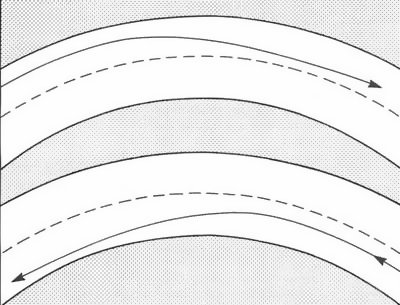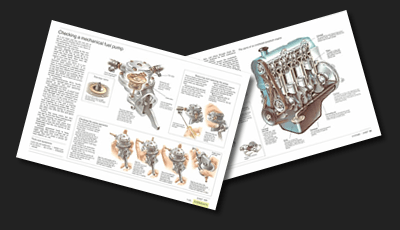A driver never has anyone to blame but himself if he goes off the road on a bend. The results can be disastrous, especially if such foolhardy driving results in a collision with another vehicle. Yet drivers often do not regard themselves as being at fault - excuses may be given about adverse camber, the road being greasy or the curve tightening up unexpectedly. Any of these can be factors in an accident, but never the cause. The reason for going off the road always lies in bad driving in one form or another.
Cornering forces
The optimum line for negotiating a right- or left-hand bend on a two-way road. 'Straightening' the curve in this way removes some of the danger from bends in roads, but should not be attempted if it involves changing lanes with other traffic nearby — and don't cross the central line unless you are quite certain that there is no car coming the other way.
It is worth analysing the forces which act on a car when it is steered round a corner. A car's momentum takes it in a straight line (just like a golf ball struck true and straight down the fairway) until the driver turns the steering wheel. The front wheels move to a position at an angle to the straight path they are following and the car starts to turn into the bend. At this point centrifugal force begins to act, trying to push the car outwards in the same way that a piece of string with a weight at the end tautens when you swing it round in the air. This force is felt inside the car as it pushes you sideways in your seat, away from the inside of the bend. A car with soft suspension also reacts by rolling down on its springs on the outer side.
This video course is the best way to learn everything about cars.
Three hours of instruction available right now, and many more hours in production.
- 4K HD with full subtitles
- Complete disassembly of a sports car
The tyres have to work harder to resist centrifugal force as they are subjected to this curved path, and those on the driven wheels also have to deal with the business of transmitting power to the road. The faster a corner is taken, the harder the tyres have to work. It goes without saying that there comes a moment when a driver can ask too much of his tyres, causing them gradually to lose their grip; a skid will start and the car may run off the road.
The right course through a bend
Avoiding excessive speed through corners is quite obviously a prerequisite of safe driving, but it is important also to take bends as smoothly as possible. Smoothness allows a driver to corner at reasonable speed without putting too much stress on the tyres. One technique to make cornering that little bit smoother and safer is to 'straighten' a bend slightly, but without crossing the central line. Never cut across the inside of a bend because it could endanger or worry other road users. Just because you may have heard racing drivers talk about `straightening' a bend does not mean that there is any virtue in dashing through corners; on a race circuit speed is the object, drivers can use the full width of the road and all the cars travel in the same direction. None of this applies on the public road. We are talking about a milder version of 'straightening' a bend, whereby it is permissible to make sensible use of the width of your side of the road to ease the curve and improve your view round it.
Let us take the example of a right-hand bend. To take the best line through, enter the bend well over to the left of the road, then gradually move a little towards the middle so that your offside wheels are close to the central white line as you pass the apex. By using this line, the widest possible arc, you gain the best and earliest view out of the bend and reduce the centrifugal force on the tyres. All of this should be done with such subtlety that it is really not obvious to other road users; this technique should never be exaggerated, and you should err towards a regular line when there is other traffic about. If someone is stupid enough to attempt to overtake you through a corner, keep well to the nearside and slow down to give him more margin if his error gets him into difficulties with oncoming traffic.
Cornering procedure in detail
The generalisations which can be made about procedure through bends are limited, but on right-hand bends this should be your basic programme:
- As the bend approaches, check your mirror in case someone is coming up behind or even contemplating nipping by before — or, worse still, through — the corner.
- Judge the speed at which you should take the bend and carry out any braking necessary to slow down to that speed while the car is still moving in a straight line. Your speed should be such that you can always pull up within the distance you can see to be clear.
- While you are still travelling in a straight line, change down to a lower gear if it seems necessary so that acceleration is available as you leave the bend.
- Bear in mind the racing driver's adage, 'in slow, out fast', although do not place too much emphasis on the `fast'.
- Start steering into the curve, taking care to make a smooth movement rather than a vicious tug at the wheel which will jerk the car into the bend.
- Press the accelerator slightly as the car responds to the steering. Any car will feel steadier under a little power rather than a trailing throttle, but this must be done very gently and smoothly.
- Look towards and past the apex to check that the exit is clear. Throughout the corner you should always be driving at a speed which allows you to brake to a standstill within the distance you can see.
- Push the throttle more firmly so that you can accelerate smoothly out of the bend as you pass the apex. This should be done well within the capabilities of your car, as too much power will overload the tyres and cause them to slide, especially if the road is wet. Remember that extra power may cause the car to run a little wide, so compensate as you steer through.
The reverse applies through a left-hand bend: make your approach towards the middle of the road while staying on the correct side of the central line, move over towards the nearside at the apex and then gradually ease back to your correct position, a few feet from the verge, at the end of the bend.
Braking on a bend
You should always avoid braking on a bend, but there will be occasions when there is no option. A pedestrian may step out into your path or you may overestimate the safe speed. When it is necessary to brake, apply pressure as lightly as possible to the pedal to avoid asking too much from the tyres. If there is room, try to straighten the steering just before you brake, then turn again as you take your foot off the pedal.
You may be faced with a situation where heavy braking is necessary on a corner, although the advanced driver should seldom need to do so. He will have correctly judged the safe speed for the conditions, remembering that it is better to arrive at a corner too slowly than too quickly. He will have carefully assessed the road ahead as he approaches the corner and drives through it, making allowances for any pedestrains or vehicles likely to wander into his path. He will also have allowed for the bend tightening up or leading directly into another bend beyond his line of sight. All the possibilities will have dictated a conservative and safe speed into the corner, whether it is a completely open curve on a main road or a tight bend bordered by tall hedges on a country lane.
The unexpected can lie around any corner, and usually results from a driver being guilty of miscalculating the vehicle's speed so that there is difficulty in stopping when faced with a broken-down car, a tractor or a loose animal. The unexpected, however, could be another driver approaching on the wrong side of the road or, worse still, having an accident. It is better to try to steer away from such an alarming hazard rather than to brake on the corner. As well as increasing the chances of your own car skidding, braking can often leave you well placed to be struck by the other vehicle. Steering away from it provides a better chance of missing it altogether or perhaps receiving just a glancing blow. Never brake hard and steer at the same time.
If a car in front of you travelling in the same direction starts to slide, it is best to try to brake first to wipe off some speed (remembering the dangers involved in braking heavily while cornering), then prepare to steer to avoid the car. Keep an eye on its movement all the time: depending on the car's characteristics and the driver's action, it might plough off or spin towards the outside of the corner, or alternatively spin off towards the apex. With good judgement, you might be able to steer whichever side of the car offers the best path through if for any reason you cannot pull up first.
Summary
Always steer smoothly through a corner, and slightly straighten a bend (without crossing the central white line) to improve your view and to reduce the stress on your car's tyres.
Follow the correct cornering procedure: judge the safe speed for the corner, brake and change down to a lower gear if necessary while still moving in a straight line, and apply the power gently once you have entered the curve.
Avoid braking in a bend; bear in mind the extra force on the tyres caused by braking while steering if a miscalculation or an emergency makes it necessary to brake on a corner.




